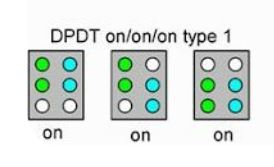Your Solstice build and comments in the thread inspired me to come up with a tone/character switch.
Using a Type 1 on-on-on, you could have three values for C16.
Picofarad values (from Tayda's monolithic selection) to play with 100 150 220 270 330 470 560 680 820 1000 — (1000p=stock).
Using 3 caps of your choosing, you'd solder the central switch position cap between lugs 1&6 (type 2 lugs 3 & 4), with the other two caps soldered to 1&4 and 3&6 — signal in to 2 and out from 5 as per normal. At no time are any of the caps in series or parallel with each other.
Actually, the diagram shows a DP
3T, if you wanna get technical.
The outer switch-positions’ caps are not in the circuit when bat is in middle; when bat activates 1&4 the centre-diagonal cap is not in the mix because 5&6 are unconnected, and vice versa for cap on 3&6 where the 1&4 and diagonal are not recognised — so 3 separate Values can be attained and placed in order of preference — what I like about this as opposed to doing the same with on-off-on and caps in parallel is that you don't have to have the smallest value in the middle position — it can be a logical low-to-high or high-to-low.
So…
what'll it be?
100p, 560, 1n OR
100p, 470p, 820p OR
220p, 680p, 1n OR
150p, 330p, 680p OR

— OF COURSE ONE COULD JUST BREADBOARD/SOCKET IT AND FIND A PREFERRED OVERALL VALUE, if the differences are too subtle.
Now extrapolate and use this method on an input cap, or other significant signal shaper in a circuit... Maybe the tone cap in a Rat or 808.
Use a
4PDT 4P3T on-on-on (essentially two DP3Ts) on a Muff Tone control...



